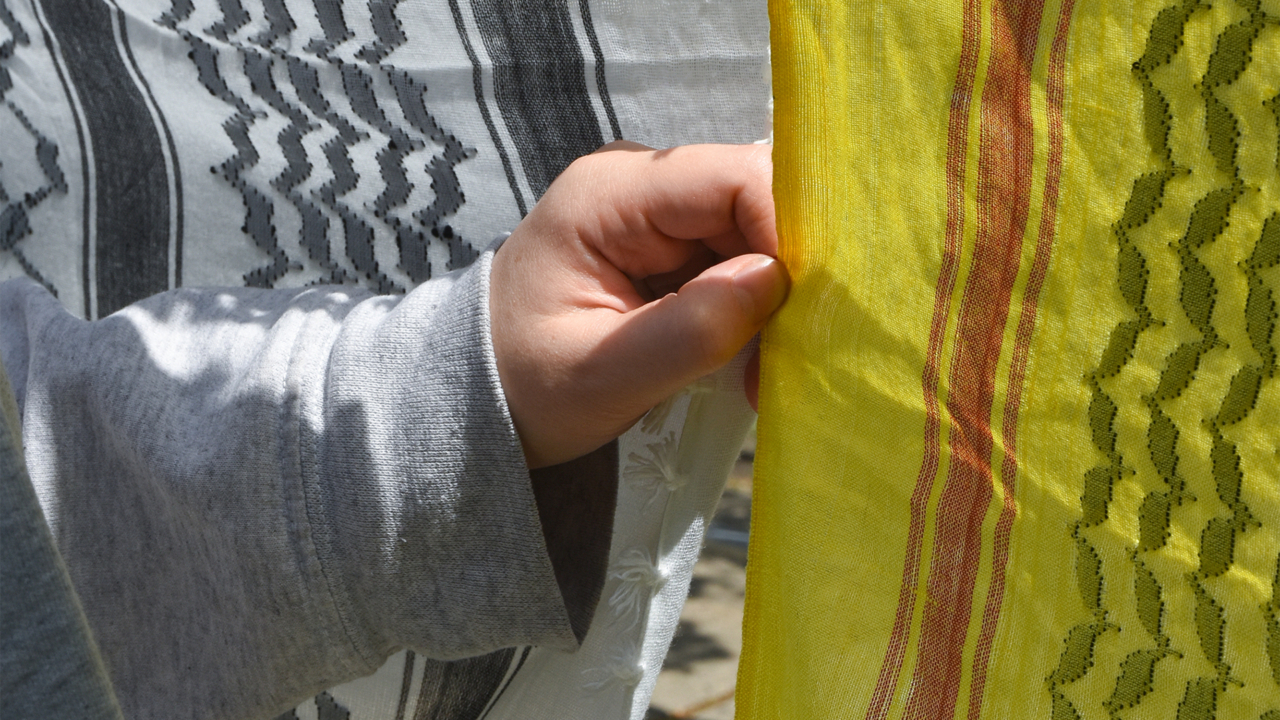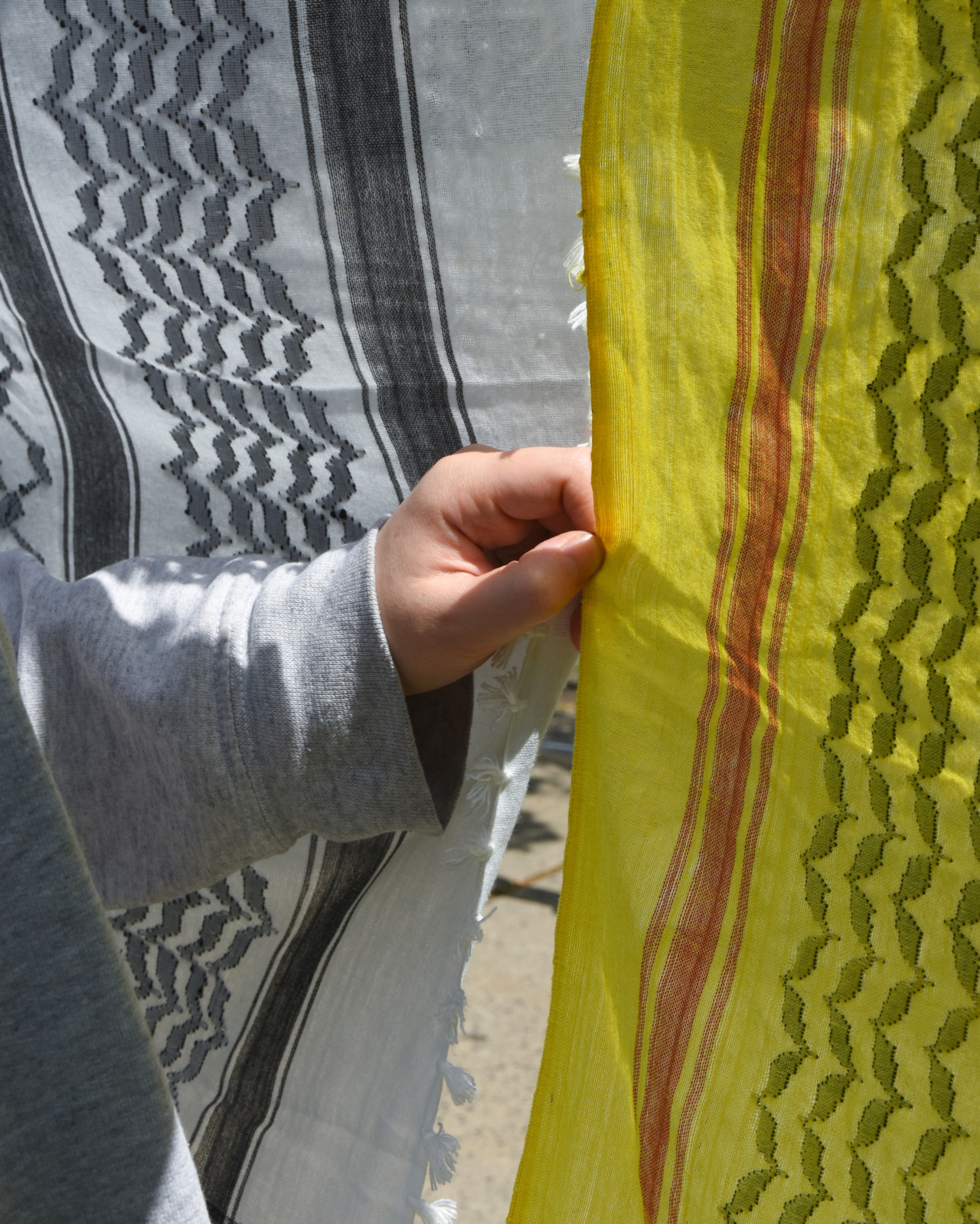

Photograph by Hannah La Follette Ryan
Words by Liana DeMasi
On a Wednesday in late April I was walking up 139th Street in Harlem, New York, carrying a bag containing a pack of tampons, one bottle of dish soap, 12 packets of Emergen-C, and six packs of Advil. The guy behind the counter at the bodega had invited me behind the glass, so that I could clear out whatever inventory I needed. I showed him my “shopping list,” which was a screenshot of a supply list that had been sent to me in a Signal group composed of faculty and staff in solidarity with the City University of New York Gaza Solidarity Encampment (CGSE). The man gave me a sort of half-salute as I took back my credit card, and I smiled at his subtle camaraderie.
When I arrived at the CGSE, a child was standing in the quad’s center, surrounded by large painted canvases calling for Palestinian Liberation and signs that named some of the Palestinian children who had been killed by the Israeli military in Gaza. This young girl’s hijab was lightly blowing in the wind as she led the encampment, a growing crowd, in a chant: “Free, Free Palestine!”
I moved through some of the tents, past the People’s Library—a raised slab of concrete that was now covered in books by Audre Lorde, Angela Davis, and Edward Said—and caught sight of some tents labeled “Medic,” “Supplies,” and “Food.” Making my way over, I emptied my bag of supplies and helped a handful of encampment residents reorganize some of the tables. As we finished lining up the masks, sunscreen, and bandaids, another person was handed the microphone and announced that an art circle would begin right after a Muslim prayer. Several people moved to hold tarps up in front of the cameras, so that those praying could do so with privacy. Back in the center of the quad, I spotted a large, double-sided whiteboard that listed the day’s scheduled activities, which included yoga, a teach-in about the history of Puerto Rico as well as several solidarity poetry readings.
“They think this type of repression and violence is going to scare people into sitting on their hands, into being complacent. But it does the opposite. It radicalizes us even further.”
Six days later, on April 30th, the CUNY Gaza Solidarity Encampment was raided and dismantled by the NYPD, including members of counterterrorism units and the notoriously violent Strategic Response Group. Just south of City College’s campus, Columbia’s encampment saw the same fate. Some 280 protestors were arrested that night, many with brutal force. The tents and personal belongings, the People’s Library, the canvases and posters calling for a free Palestine, a free Sudan, a free Congo, a free Puerto Rico, were trashed as students, faculty, staff, and community members were ushered into NYPD and MTA buses headed downtown for mass processing.
“They think this type of repression and violence is going to scare people into sitting on their hands, into being complacent,” says T.L., a Columbia Gaza Solidarity Encampment member, who requested we only use their initials on legal and safety grounds. “But it does the opposite. It radicalizes us even further.”
Following in the footsteps of Columbia University, schools around the country and the world—like Oxford University and London School of Economics in the U.K., and the Paris Institute of Political Science in France—are forming encampments in solidarity with the people of Gaza.
Encampments as a form of protest are nothing new. Throughout history, encampments have formed across colleges and universities calling for an end to injustice, such as the intersectional student protests of the late 1960s and early 1970s that demanded an end to the Vietnam War and South African Apartheid, while fighting for Black Liberation and worker’s rights. And in a way that is also historically recurrent, school administrators facilitated by local, state, and federal officials have called for the violent suppression and dismantling of these forms of protest, in mass.
“Nothing surprised me about [what happened on April 30th],” says Hadeeqa Malik, a sophomore at City College of New York and vice president of the college’s Students for Justice in Palestine (SJP). “This kind of repression is expected when we’re challenging the status quo. Working toward Palestinian Liberation, Black Liberation, Liberation for all…it means that their empire is falling.”
If we continue to see instances of police tear gassing, pepper spraying, beating, and brutalizing unarmed students and the faculty, staff, and community members that stand with them, the myth that law enforcement is there to “serve and protect” us is dismantled before our eyes. If we continue to see former presidents call the police brutality against student demonstrators and encampments “beautiful,” the veil continues to fall. This is especially true when their reasoning for such brutality is the protection of buildings, property, and order instead of the protection of human life and an end to genocide in Gaza that the very students being suppressed are demanding. What’s more, the majority of these encampments are led by students of color and other disenfranchised communities who have historically been subjected to indiscriminate police violence.
As we bear witness to this continuous abuse of power, we are forced to interrogate what the authorities really mean by “keeping the peace.” What does “peace” mean in this context? And who does it serve?
The reality is that student-led movements have the power to change minds and save lives in the face of injustice.
Back in the summer of 2018, Greta Thunberg, then 15 years old, sat outside the Swedish parliament for the first “School Strike for Climate.” From there, over a million students from around the world engaged in similar strikes, calling on their governments to better address the climate crisis. In 2023, a youth-led climate activist group called End Fossil called for students to occupy their schools and universities in protest against governmental and institutional inaction against climate change. They followed in the footsteps of previous protestors, like those at the University of Barcelona in 2022 who succeeded in implementing a mandatory climate crisis course for all students and faculty.
The reality is that student-led movements have the power to change minds and save lives in the face of injustice.
Today, as students are advocating for a ceasefire and an end to Israel’s occupation, they’re raising awareness about the continued exploitation of Palestinian people and their land. Israel awarded gas exploration licenses to six fossil fuel giants, including BP and their own oil company, Ratio Energies, allowing them to drill off the coast of Gaza. In the West Bank, settlers set fire to Palestinian olive trees, and in Gaza, IDF bombings both destroy crops and separate farmers from their olive trees. While the burning of olive trees by Israel and West Bank settlers predates the events of October 7th, the inaccessibility to and destruction of olive trees was acutely painful for Palestinians in the attack’s aftermath, as October and November are harvest season, which represents a time of connectivity to the land. It’s with these climate injustices in mind that student encampments are incorporating environmental advocacy into their work.
At the Columbia Gaza Solidarity Encampment, T.L. detailed how they smuggled zines from various encampments across the country through Columbia’s locked, wrought iron gate, which were then distributed throughout the Columbia encampment. T.L. said these zines helped erode lingering class hierarchy, an inherent dynamic at an Ivy League institution that impeded some of the camp’s decision-making processes and interpersonal relations. They also expressed that these zines helped to contextualize the long history of university students’ dedication to justice through collective action. For inspiration and empowerment, some of the zines outline how students at Columbia, like City College of New York, can look back at the 1969 protests and riots that took place on campus to help inform their organizing today.
“I know it sounds crazy, but when you’re doing that kind of collective work, you’re moving in one body, one organism. Names almost become irrelevant,” T.L. says. “The idea of the individual falls away.”
If we consider each encampment as a microcosm, they can become blueprints for the future; for a better world.
Many encampments, including CUNY’s, went up during Passover, and organizers quickly and meticulously planned evening Seders that complemented the separate Kosher items under the food tent. Muslim prayer times were announced five times a day. Medical tents were stocked with supplies and manned by volunteer medical professionals and students. Free mental health services were offered to organizers and participants, and in the aftermath of the police brutality of April 30th, mental and holistic healthcare services, like reiki, have been offered pro bono for arrestees. This is a space where insurance cards are not asked for, where no one is turned away over a lack of funds; it’s a place where care is an implicit and explicit part of the work.
“The liberation of Palestinians inherently entails the liberation of everybody. This truly is the People’s Revolution.”
These encampments are most often connected to the work of other activists back in 1968, but the fight for liberation is relentless, cumbersome, and centuries-long. Collective action, historically shaped by people of color, has always been made possible by a faction of people who are unwavering in their commitment to collective liberation. And while that faction may be composed of people the world over who are separated by university grounds, state lines, or even preferred methodology for collective action, the end goal remains.
In fact, those lines of separation are what seem to inspire and unify the most. In the face of polarization fueled by government and media disinformation, increased and militarized border security, police violence, racial injustice, and innumerable state-sanctioned methods to make us fear and hate one another, we are guided, led, and unified by the urgency of our mission. These encampments can help build a blueprint for a more just world; they are a timely and necessary reminder that we belong to one another, that this is our fight, our freedom, our liberation. “Free Palestine means a free world. The liberation of Palestinians inherently entails the liberation of everybody, ” Hadeeqa says. “This truly is the People’s Revolution.”
Why Student Protests for Gaza Are Microcosms for a Better World